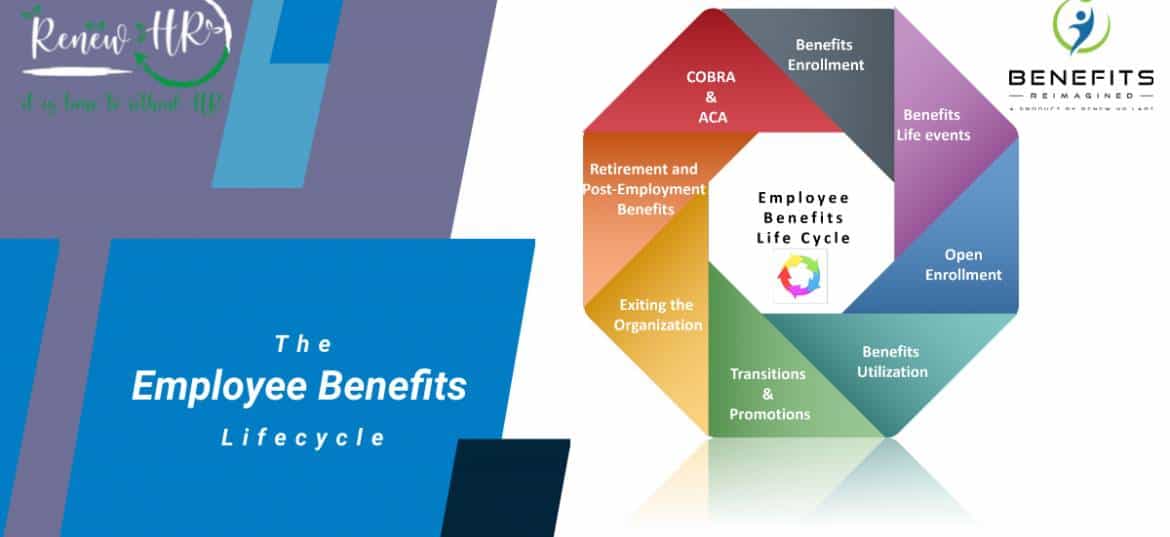When discussing the employee benefits lifecycle, we refer to the entire journey employees experience with their benefits, from onboarding to retirement. It’s more than just health insurance or retirement plans; it’s an ongoing process of benefits communication, engagement, and adjustment based on an employee’s needs, life events, and career development.

The employee benefits lifecycle
Broadly employee Benefits can be divided into two major segments traditional and non-traditional. Traditional benefits are the standard offerings provided by employers to employees, including health insurance, retirement plans, paid time off, disability insurance, life insurance, and employee assistance programs.
On the other hand, non-traditional benefits are additional perks and incentives to enhance work-life balance, well-being, and job satisfaction. These benefits include flexible work arrangements, wellness programs, childcare assistance, paid volunteer time, professional development opportunities, financial planning resources, and more. While traditional benefits are expected in most workplaces, non-traditional benefits help companies stand out, attract top talent, and foster a positive work culture.
Traditional vs. Non-Traditional Benefits
At the heart of any benefits strategy is a combination of traditional and non-traditional employee benefits.
- Traditional benefits include the essentials: health insurance, dental/vision coverage, 401(k) plans, paid time off, life insurance, and disability coverage.
- Non-traditional benefits are the game-changers: flexible work schedules, wellness programs, childcare support, paid volunteer hours, mental health resources, and financial education. These perks enhance the employee experience, boost retention, and distinguish companies in a competitive talent market.
Let’s walk through each stage of the employee benefits lifecycle and explore how thoughtful design, timely benefits communication, and strategic tools can boost engagement and satisfaction.
-
Onboarding Benefits: Making the First Impression Count
The first significant benefit of lifecycle management is onboarding. This is when new hires are introduced to the available benefits and guided through the enrollment process.
At this stage, communication is key. Clear, jargon-free explanations and intuitive enrollment tools can make all the difference. A well-structured onboarding experience that explains both traditional and non-traditional benefits, helping employees feel supported. From day one.
💡 Pro tip: Offering flexible work options or wellness stipends during onboarding can boost employee benefits engagement early in the lifecycle.
-
Active Employment: Engaging with Benefits Daily
Once employees are fully onboard, they enter the active employment phase, where they utilize and engage with their selected benefits. During this stage, employee benefits become a part of everyday life.
Examples include:
- Using health insurance for preventive care
- Taking advantage of paid leave
- Enrolling in wellness programs or professional development courses
- Participating in team building or work-life balance initiatives
It’s also a time to consistently reinforce benefits communication, not just during open enrollment, but throughout the year. Sending timely updates and reminders about underused benefits can keep employees informed and engaged.
-
Life Events & Changes: Adapting to New Realities
Major life events like marriage, childbirth, adoption, or even divorce can trigger updates to employee benefits. A responsive and flexible benefits management lifecycle ensures that employees can easily make the necessary changes without headaches.
Non-traditional support also plays a huge role here:
- Parental leave, adoption support, or resources for new parents
- Elder care benefits for employees managing aging relatives
- Emergency assistance or mental health support during personal crises
A streamlined process, combined with empathetic communication, helps reduce stress during emotionally charged times.
-
Annual Enrollment: The Benefits Renewal Process
Each year, the benefits renewal process provides employees with an opportunity to reevaluate and adjust their benefit selections. For HR teams, this is one of the most critical stages in the employee benefits lifecycle.
To ensure success:
- Start the benefits enrollment process early
- Use targeted messaging across multiple workplace communication tools
- Personalized content based on employee demographics and past choices
📢 Remember: Employees who understand their benefits are far more likely to make informed choices—and stick around longer.
-
Leaves, Promotions, and Internal Moves
When employees take leave (e.g., medical or parental leave) or transition into new roles, their benefits may need to be paused, transferred, or updated accordingly.
Make sure your system supports:
- Clear policies for benefits during leave of absence
- Automatic updates for promotions or job changes
- Role-based benefits that align with new responsibilities
-
Offboarding: Navigating the Transition Out
When employees exit—whether due to resignation, retirement, or termination—it’s essential to handle the transition with clarity and compliance. This includes:
- Final paycheck calculations
- Termination of certain benefits
- Guidance on COBRA coverage or retirement benefit options
COBRA, especially, is a vital piece of the employee benefits lifecycle in the U.S., offering a temporary extension of health coverage. Employers must ensure that their COBRA administration aligns with ACA rules to avoid penalties.
-
Post-Employment & Retirement Benefits
For retirees, the journey doesn’t end. Access to retiree health plans, pensions, or continued financial planning resources helps support long-term well-being.
Retirement-stage benefits might include:
- Access to 401(k) rollovers or payout options
- Retiree healthcare options
- Post-employment financial counseling

Why It All Matters
Managing the employee benefits lifecycle is more than an administrative task—it’s a strategic opportunity. When done right, it leads to:
- Higher employee benefits engagement
- Increased talent retention
- Improved workplace satisfaction
- Fewer compliance issues
- Strongly employed brands
To succeed, companies must combine effective benefits communication, smart automation, and strong systems that streamline the management of the lifecycle from start to finish.
How Benefits Reimagined Supports the Lifecycle
At Benefits Reimagined, we support the full employee benefits lifecycle — from onboarding to retirement. Our platform blends modern UI, advanced automation, and personalized employee benefits management to meet today’s expectations.
Whether it’s simplifying the benefits enrollment process, personalizing messages for life events, or managing COBRA transitions, Benefits Reimagined provides both traditional and non-traditional tools that drive actual impact.
✅ Ready to reimagine your benefits journey? Let’s make every stage count.
